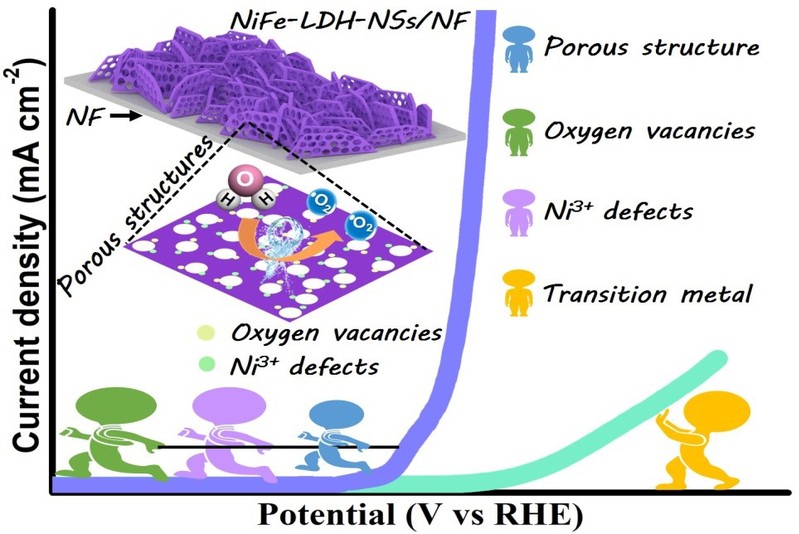Multiple structural defects in ultrathin NiFe-LDH nanosheets synergistically and remarkably boost water oxidation reaction
Zhongyin Zhao , Qi Shao , Jiangyan Xue , Bolong Huang , Zheng Niu , Hongwei Gu , Xiaoqing Huang , Jianping Lang

Modifying electrocatalysts nanostructures and tuning their electronic properties through defects-oriented synthetic strategies are essential to improve the oxygen evolution reaction (OER) performance of electrocatalysts. Current synthetic strategies about electrocatalysts mainly target the single or double structural defects, while the researches about the synergistic effect of multiple structural defects are rare. In this work, the ultrathin NiFe layered double hydroxide nanosheets with a holey structure, oxygen vacancies and Ni3+ defects on nickel foam (NiFe-LDH-NSs/NF) are prepared by employing a simple and green H2O2-assisted etching method. The synergistic effect of the above three defects leads to the exposure of more active sites and significant improvement of the intrinsic activity. The optimized catalyst exhibits an excellent OER performance with an extraordinarily low overpotential of 170 mV at 10 mA·cm−2 and a small Tafel slope of 39.3 mV·dec−1 in 1 M KOH solution. Density functional theory calculations reveal this OER performance arises from pseudo re-oxidized metal-stable Ni3+ near oxygen vacancies (Ovac), which suppresses 3d-eg of Ni-site and elevates d-band center towards the competitively low electron-transfer barrier. This work provides a new insight to fabricate advanced electrocatalysts for renewable energy conversion technologies.
超薄NiFe-LDH纳米片中的多个结构缺陷协同显著促进水氧化反应
通过面向缺陷的合成策略修改电催化剂纳米结构并调整其电子性质对于提高电催化剂的析氧反应(OER)性能至关重要。目前关于电催化剂的合成策略主要针对单一或双重结构缺陷,而对多种结构缺陷协同效应的研究很少。在这项工作中,通过使用简单的绿色 H 2 O 2在泡沫镍上制备了具有多孔结构、氧空位和 Ni 3+缺陷的超薄 NiFe 层状双氢氧化物纳米片(NiFe-LDH-NSs/NF)。-辅助蚀刻法。上述三个缺陷的协同作用导致更多活性位点的暴露和内在活性的显著提高。优化后的催化剂表现出优异的 OER 性能,在 10 mA·cm -2 时具有 170 mV 的极低过电位和在 1 M KOH 溶液中 39.3 mV·dec -1的小塔菲尔斜率。密度泛函理论计算表明,这种 OER 性能源于伪再氧化的金属稳定 Ni 3+近氧空位 (O vac ),它抑制了 3d-e gNi 位点并将 d 带中心提升到竞争性低的电子转移势垒。这项工作为制造用于可再生能源转换技术的先进电催化剂提供了新的见解。
DOI: 10.1007/s12274-021-3475-z

